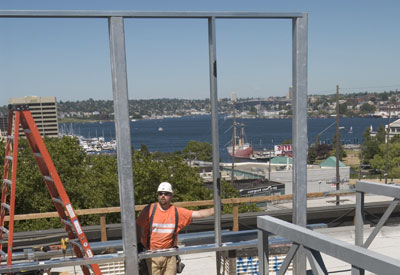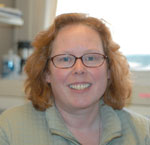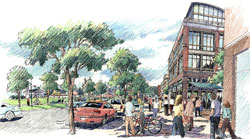Nexus for Biotech Research and Development
South Lake Union neighborhood reshapes into hub for burgeoning industry
A drive through the South Lake Union neighborhood of Seattle reveals an industrial area dotted with apartment buildings, offices, wooden boat launches, the blue copulas of a Russian church, and an elementary school. In just a few years, the neighborhood will retain some of its edge of city bordering on an urban lakefront appeal as acquires mixed use commercial, residential, office, and retail space and becomes a prime location for the city's biotech industries. People will be able to live, work, learn, and play in the neighborhood. They will walk along its pedestrian-friendly streets to offices, shops, eateries, or parks.

Lake Union forms the backdrop for the renovation of the UW Medicine at 815 Mercer building.
Among those participating in South Lake Union's re-development is UW Medicine. Biomedical research facilities are being created to fit with the neighborhood's growing role as a technological hub. The nearness of academic research and high-tech industry will foster collaborative projects that could lead to better diagnostic techniques, drug treatments, and other medical advances.
"South Lake Union is key to UW Medicine's ability to lead a significant portion of the nation's biomedical research enterprise well into the 21st Century," said Dr. Paul Ramsey, dean of the UW School of Medicine and vice president for medical affairs. "The opportunities for research collaboration across organizational and disciplinary lines are already enormous here, and the future holds much promise for UW Medicine to develop new interdisciplinary initiatives."
 |
| Construction workers handle various responsibilities in creating facilities for technology development. |
Though UW Medicine has had a presence in the South Lake Union area since 1999, when researchers in microbiology, laboratory medicine, and bioengineering first occupied the Rosen Building, it expanded that presence in 2004 with the renovation of the former Washington Natural Gas building at 815 Mercer St. by Vulcan Inc., the company leading the re-development of South Lake Union.
School of Medicine researchers will move into the 815 Mercer building in early 2005. Although they belong to many different disciplines and departments, the researchers will be united by their interest in viable clinical applications and their ties to industry.
"Overall, what we're envisioning for South Lake Union are synergistic centers and programs focused on translational medicine - taking basic science research and applying it to clinical problems," said Dr. Albert Berger, vice dean for research and graduate education and professor of physiology and biophysics. "The scientists moving to South Lake Union have a strong interest in studying diseases, trying to understand their fundamental mechanisms, and developing better diagnostic techniques, cures, and preventions."
 |
| Cancer vaccine researcher Dr. Nora Disis is among several UW medical scientists moving to South Lake Union labs. |
Located in the 815 Mercer building will be the Center for Translational Medicine in Women's Health, with Dr. Mary L. "Nora" Disis, associate professor of medicine in the Division of Medical Oncology. She will serve as the center's director. Researchers will study the types of cancer prevalent in women, such as breast, ovarian, and cervical cancer. They hope to design new diagnostic tools for those types of cancer, as well as vaccines and immune-system based therapies that could prevent or treat cancer, or stop its re-occurrence.
"We hope that over the years, as we recruit people into center, we can expand, not only to other types of cancers affecting women, but also to other important women's diseases, such as cardiovascular disease," said Disis.
In fact, researchers from Disis' group have already discussed collaborating with people in the UW Center for Cardiovascular Biology and Regenerative Medicine, another large part of the UW Medicine presence in South Lake Union, on projects related to cardiovascular disease in women. In that center, investigators will use cellular and molecular techniques to better understand cardiovascular disease, one of the leading causes of death in the United States.
Both centers are examples of a new paradigm in biomedical research at the UW, scientists say: one that attempts to solve a particular problem without being constrained by departments or disciplines.
"The big thing that this represents is the opportunity to build a program where people are at the same place at the same time working on a similar problem," said Dr. Charles Murry, associate professor of pathology and director of the Center for Cardiovascular Biology and Regenerative Medicine. "At any university, by nature of the organizational structure, it's a piecemeal operation. You're working together, but not located together. Because this space will be based on research centers, not on departments, it will allow us to be located together. We're getting brand new labs and we'll have as our nearest neighbors those people who will be our best collaborators."
The new UW Medicine research space at South Lake Union will also put researchers in close proximity to their counterparts in the biotech industry, said Dr. Disis, giving the facility "a totally different feel."
 |
| A sketch of the pedestrian-friendly promenades planned for South Lake Union. |
Being near other players in the biotech industry could also provide a vital source of funding, researchers said.
"For translational science, you can't do it exclusively funded by federal sources," Murry said. "When you need to scale up and move it forward, you can't do it with funding from the National Institutes of Health. It's very important to develop that public/private relationship."
That's why the UW operations moving to South Lake Union hope to translate scientific research into useful, marketable products.
"Because the School of Medicine is interested in moving research from laboratories to clinical applications, it's essential that the research there be of interest to the private sector," said Dr. Berger. "A lot of researchers moving to South Lake Union have connections to the private sector in pharmaceuticals and biotechnology. The point of South Lake Union is to create a nexus of biotech research and development."
That nexus will include current and future biotech research facilities of such institutions as Children's Hospital and Regional Medical Center, the Fred Hutchinson Cancer Research Center, the Seattle Biomedical Research Institute, Merck, and ZymoGenetics.
Development note Funding construction takes a vision of what expanded space, ease of communication, and close collaboration can mean for researchers and patients. A number of generous visionaries are supporting the South Lake Union research hub, among them Jeff and Susan Brotman, Orin Smith, Scott and Laurie Oki, and KeyBank. |